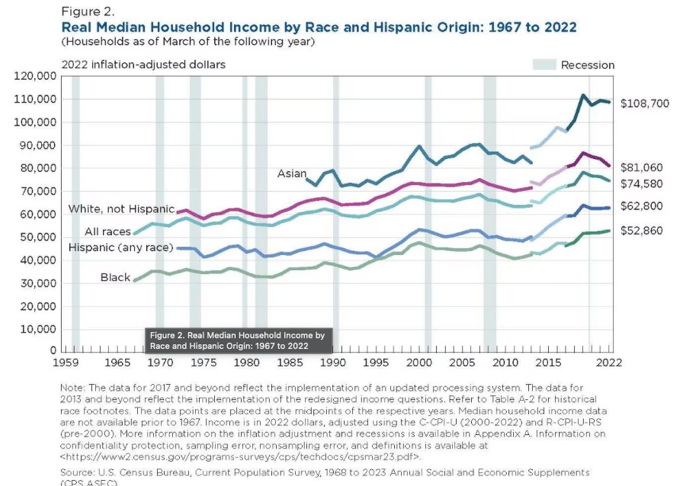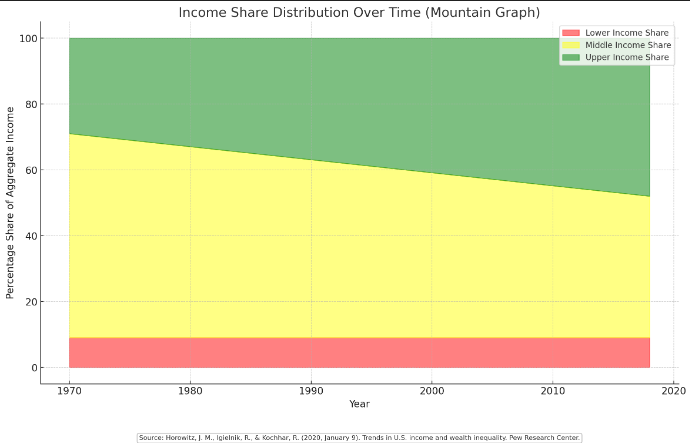
In the United States, the widening chasm of income disparity manifests through persistent issues such as low wages, minimal federal wage standards, the prevalence of working poor, homelessness, and unemployment. This complex social challenge is particularly pronounced within racial wealth gaps, indicating systemic economic inequities that reverberate across communities. This paper posits that the intersection of sociology and economics holds critical insights and tools for addressing these disparities. The thesis contends that an interdisciplinary approach, merging economic policy reform with sociological insights into structural inequalities, is essential to devising effective strategies. It will explore how a collaborative application of these social sciences can illuminate and help dismantle the entrenched barriers to wealth equality, thus fostering a more equitable distribution of income and opportunities within the fabric of American society.
The Social Issue Of Income DisparityÂ

The disciplines I have chosen to gain insight into the social issue of income disparity are economics and sociology. Income disparity in the U.S. encompasses a range of interconnected issues, including low wages and the minimum wage debate, the phenomenon of the working poor, homelessness, and unemployment. According to a Pew Research article by Horowitz and Kochar (2020), “From 1970 to 2018, the share of aggregate income going to middle-class households fell from 62% to 43%. Over the same period, the share held by upper-income households increased from 29% to 48%.

The share flowing to lower-income households increased from 10% in 1970 to 9% in 2018” (Upper-income households section, para. 5). This social problem is fundamentally rooted in the unequal distribution of income and wealth, which leads to significant segments of the population living in poverty despite the country’s overall wealth. Concepts from sociology, such as social stratification, illuminate how income disparity is not merely an economic issue but a complex social problem that affects access to basic needs, education, healthcare, and opportunities for upward mobility. Individuals who are employed yet remain impoverished underscore the insufficiency of minimum wage rates across numerous regions in the nation (Addo & Darity, 2021).
Meanwhile, unemployment and underemployment contribute to a cycle of poverty that is difficult to break, often leading to homelessness and further marginalization. The issue of income disparity reflects broader systemic inequities. It raises questions about fairness, social justice, and the role of government in redistributing resources to change the disparities that exist for the better.
Sociology’s Perspective on Income Disparity

From sociology’s vantage point, income disparity is not merely a matter of economic statistics but a complex phenomenon deeply embedded in the fabric of society. The study by Paul, Englert, and Varga (2020), focusing on socioeconomic disparities and COVID-19 in the USA, represents a significant contribution to the sociology discipline by examining how socioeconomic factors influence the spread and impact of COVID-19 across different communities (Paul et al., 2020).
This research falls within medical sociology, a branch of sociology that scrutinizes the social determinants of health and illness and how society is affected by these health issues. The authors likely utilized a quantitative methodology, given that the study focuses on socioeconomic disparities, which often involves analyzing statistical data to identify patterns, correlations, and outcomes related to COVID-19 infection rates, severity, and mortality among different socioeconomic groups.Â
 The Differences & Similarities In This StudyÂ

One similarity between this study and others within the sociology discipline is the focus on social inequalities and their impact on health outcomes. However, two differences might be observed in comparison to studies using qualitative methodologies or those focusing on other social issues. Firstly, the quantitative approach allows for a more objective measurement of disparities and their direct correlation with COVID-19 impacts, as opposed to qualitative studies that might explore individual and community experiences and perceptions of the pandemic in depth. Secondly, this study’s focus on socioeconomic disparities offers insight into the COVID-19 pandemic, which might differ from studies examining the pandemic’s impact through other sociological lenses, such as race, gender, or age. These differences highlight the diverse methodologies and focal points within the sociology discipline, underscoring the importance of multi-faceted approaches to comprehensively understanding complex social issues like the COVID-19 pandemic.
Economics’ Contribution to Understanding Income Disparity

Economics contributes a critical lens to understanding income disparity by dissecting the mechanisms of wealth accumulation and distribution and evaluating policy’s profound impact on economic inequality (Hernández et al., 2020). This discipline delves into the nuances of wealth concentration, meticulously analyzing how wealth is amassed and distributed across different segments of society.
Through rigorous quantitative analysis, economics sheds light on policy’s pivotal role in shaping economic outcomes, underlining the importance of policy interventions in addressing economic disparities. Methodological Approaches Both disciplines employ different methodologies to study income disparity. Sociology often utilizes qualitative methods to understand societal impacts on economic outcomes, while economics frequently applies quantitative analyses to trace wealth concentration and evaluate policy impacts.
Similarities and Differences in Approaches

While sociology and economics acknowledge income disparity’s complex and multifaceted nature, they approach the issue from distinct perspectives. Sociology delves into the societal constructs, exploring how social structures, cultural norms, and institutional practices contribute to economic inequalities. Economics focuses on the structural factors influencing wealth accumulation and distribution, particularly how policies shape economic outcomes. The Great Recession highlighted a sharp rise in wealth inequality, evidenced by an increase in the Gini coefficient (Income inequality measure) from 0.83 to 0.87.
Despite this, the wealth share of the top 1% barely moved, increasing by less than one percentage point. This scenario underscores a widening wealth gap across the broader population, while the wealth concentration at the top remained relatively unchanged, as Wolff (2017) detailed. This analysis underscores the complex interplay between economic structures and wealth distribution during significant economic downturns.
Despite these differences in methodologies and focal areas, both disciplines converge on a crucial point: the importance of interdisciplinary approaches in achieving a comprehensive understanding of income disparity. This consensus underlines the recognition that tackling economic inequality effectively requires integrating insights from sociology and economics, highlighting the value of collaborative efforts in addressing this pervasive social issue.
How The Selected Sources Handle Income Disparity

Examining wealth inequality in America through the selected sources reveals a multifaceted approach to understanding this pervasive social issue. Studies by Hernández Kent & Ricketts (2020) and Wolff (2017) primarily employ quantitative methodologies, analyzing economic and household wealth data to trace the trajectory of wealth disparities over time. This approach is instrumental in highlighting the quantitative aspects of wealth distribution, allowing for a detailed analysis of trends and patterns that underscore the growing gap between different socio-economic groups.
On the other hand, Laubacher et al. (2023) likely adopt a mixed methodology, integrating quantitative data with qualitative insights to explore the broader social implications of wealth inequality, including its impact on individuals, society, and culture. This blend of methodologies enriches the discourse by adding depth and context to the numerical data, offering a more holistic view of how wealth inequality affects various facets of American life.
A notable similarity across these studies is their reliance on quantitative data to ground their analysis. Whether through the lens of economic trends, household wealth, or the socio-economic impacts of the COVID-19 pandemic, as examined by Paul, Englert, and Varga (2020), these studies utilize numerical evidence to document and analyze the extent and evolution of wealth disparities. This quantitative foundation ensures that the discussion around wealth inequality is informed by empirical data, providing a solid basis for understanding the scale and specifics of the issue. The consistent use of quantitative evidence across these diverse studies underscores the critical role of empirical data in diagnosing and dissecting the complex nature of wealth inequality.
However, the studies diverge in their disciplinary focus and the contextual factors they consider. While Hernández Kent & Ricketts (2020) and Wolff (2017) concentrate on economic analyses of wealth trends, Laubacher et al. (2023) take a broader social science perspective, considering the cultural and societal dimensions of inequality. This difference in focus leads to varied methodologies and findings, with economic studies emphasizing the mechanics of wealth distribution and social science analyses exploring the implications of these disparities on societal structures and individual experiences.
Furthermore, the temporal focus on the COVID-19 pandemic by Paul, Englert, and Varga (2020) highlights how crises can exacerbate existing inequalities, a themeless central in the other studies. These differences underscore the complexity of wealth inequality as a multi-dimensional issue that intersects with economic, social, and temporal factors, each requiring distinct analytical approaches to fully understand their implications on American society.
The Interdisciplinary Advantage

The interdisciplinary approach, merging insights from both sociology and economics, offers a profound advantage in comprehending income disparity. This integrative method achieves a more nuanced and comprehensive understanding of the issue at hand by transcending the boundaries of a single-disciplinary perspective. It illuminates the complex interplay between societal constructs and economic mechanisms, paving the way for formulating multifaceted strategies.
These strategies are uniquely equipped to tackle the myriad dimensions of inequality, addressing the economic underpinnings and the entrenched social factors contributing to income disparity. This holistic perspective is crucial for devising effective interventions that target the root causes of inequality, ensuring a more equitable societal structure.
Social science research, encompassing sociological and economic analyses, is pivotal in addressing social problems, particularly income disparity. The insights from these disciplines offer a robust foundation for informing practical interventions within social settings. This body of research suggests a compelling need for economic policies to be harmoniously complemented with sociological interventions. Doing so makes it possible to mitigate income disparity and foster economic equity more effectively. Such a comprehensive approach recognizes the complexity of income disparity as a problem rooted in economic and social systems. Therefore, interventions designed to address this issue must be multifaceted, targeting the financial mechanisms that drive inequality while dismantling the social barriers perpetuating it, ensuring a more inclusive and equitable society.
Conclusion
In conclusion, income disparity emerges as a multifaceted challenge necessitating an integrated strategy for effective mitigation. Throughout this paper, the argument has been made favoring a holistic approach that marries economic reforms with sociological interventions. A comprehensive plan to reduce income disparities and foster economic equity has been outlined by harnessing sociology and economics’ diverse insights and methodologies.
The interdisciplinary approach advocated in this paper underscores the vital reason for understanding disparity through the lens of both disciplines. This varied understanding enables the formulation of more effective interventions that tackle the issue on multiple fronts. Thus, this paper contributes significantly to the discourse on income disparity, advocating for a collaborative and interdisciplinary method to address such complex social issues, ultimately paving the way toward a more equitable and inclusive society.
References
Addo, F. R., & Darity, W. A. (2021). Disparate Recoveries: Wealth, Race, and the Working Class after the Great Recession. The ANNALS of the American Academy of Political and Social Science, 695(1), 173–192. https://doi.org/10.1177/00027162211028822
Hernández Kent, A., & Ricketts, L. R. (2020, December 2). Has wealth inequality in America changed over time? Here are key statistics from the Federal Reserve Bank of St. Louis.
Horowitz, J. M., Igielnik, R., & Kochhar, R. (2020, January 9). Trends in U.S. income and wealth inequality. Pew Research Center.Â
https://www.pewresearch.org/social-trends/2020/01/09/trends-in-income-and-wealth-inequality/
Laubacher, M., Navarre-Jackson, L. C., Williams, A. N., Dillard, D., Pate, J., & Choi, K. P. (2023). An introduction to social science: Individuals, society, and culture.
Paul, A., Englert, P., & Varga, M. (2020). Socio-economic disparities and COVID-19 in the USA.
U.S. Census Bureau. (2023, September 12). Income in the United States: 2022-Current population reports. Census.gov.                                  https://www.census.gov/library/visualizations/2023/demo/p60-279.htmlLinks to an external site.
Wolff, E. N. (2017). Household Wealth Trends in the United States, 1962 to 2016: Has Middle-Class Recovered? National Bureau of Economic Research. https://doi.org/10.3386/w24085



Leave a Reply